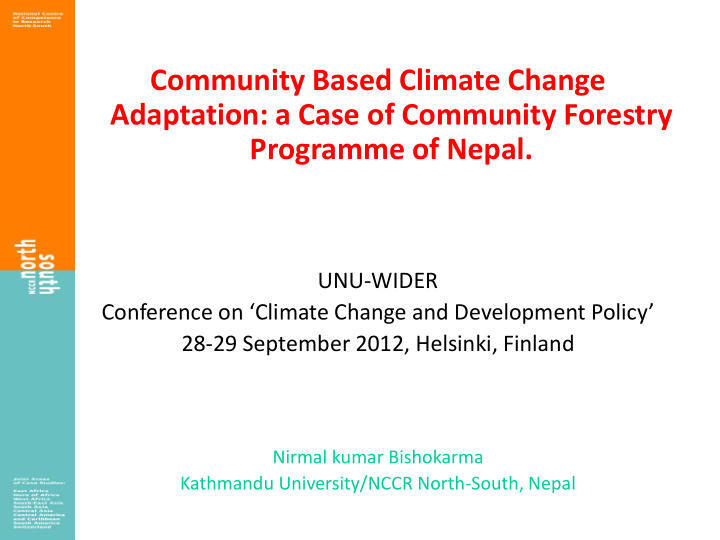



Community Based Climate Change Adaptation: a Case of Community Forestry Programme of Nepal. UNU-WIDER Conference on ‘Climate Change and Development Policy’ 28-29 September 2012, Helsinki, Finland Nirmal kumar Bishokarma Kathmandu University/NCCR North-South, Nepal
Background Community forestry programme is a major community based climate change adaptation (CBCCA) and potential mitigation mechanism, included in National Adaptation Plan for Action (NAPA)-2010 and Climate Change Policy -2011 in Nepal . Livelihoods and Forestry Programme of DFID/UK, world Bank, CARE Nepal, Practical Action, WWF (World Wildlife Fund) have been supporting implement community forestry based adaptation activities through community forestry user groups. However, there are little knowledge about the process they adopted to make the pan and its implementation, strength and weaknesses of the adaptation activities and its linkages with mitigation strategies.
Community forestry programme in Nepal Community forestry has been underway in Nepal since 1980 under which national forest are handed over to local forest user groups (FUGs). Community forestry User Groups are self regulated and autonomous institution in rural area of the country. In Nepal , to date, 17685 community Forest User Groups (CFUGs) are formed who are managing around 1.65 million hectares of forest (30% of total forest). These groups include 2.2 million households which is about 50 % of total population of country.
Study methodology Sites: Three CFUG-DFID UK area • Three CFUG-CARE area • Method Participatory methods • Data collection tools: Focus group discussions • Key informant interviews • Personal experience working as climate change focal Person in DFID UK programme
Findings and Discussions
Community experience of climate changes and its impacts on wellbeing • Increase in temperature from last 25 years. • Change in seasonality: late and erratic rainfall. • Change in farming system and negative impacts on food security • Change in availability of forest products • Drying of water sources and decreased its quantity.
Adaptation to adverse impacts of climate change Autonomous adaptation (Before CF): • Constructed check-dams / hedge against the river flow. • Water boring pump to irrigate land for preparation of seedling bed and plantation. • Change in farming system: rich people to cash crop sugarcane and others sifted time of work. • Fencing forest boundary and prohibition of entry. • Migrations • Reducing the number of cattle.
Adaptation to adverse impacts of climate change Planned adaptation (After CF) Community forest based adaptation plan involve following three types of plan and its implementation: • Community Level Adaptation Plan (CAPA) • Local level Adaptation Plan (LAPA) • Area level Adaptation Plan (AAPA)
Community based adaptation cycle in Dhankuta
Implementation of adaptation plan Establishment of Community Adaptation fund at VDC and CFUG level. Linkages of adaptation plan with ongoing CFUG activities. Inclusion of adaptation activities into VDC plan to derive government fund. Capacity building of the team and members.
Major activities implemented Forestry activities: 25% of their total fund in forest management activities i.e forest fire line preparation, operational plan preparation, thinning and pruning. Poor focused activities: 35% of total fund in income generation activities in goat keeping, forest based enterprise, scholarships, health. Equitable forest product distribution. Building road, schools, community building. Mobilization of user groups for capacity building and haphazard incidences.
Strength of planned adaptation mechanism It is suitable mechanism for planned, decentralized, cost • effective, linked and inclusive adaptation strategies . The groups provide resources including opportunities of income • to the most vulnerable sections of the groups to adapt with negative impacts of climate change. CFUGs are providing platform for organization, information • dissemination and social capital development of the marginal communities. CFUGs are entry points for wider service delivery. Most of the • state, local government, NGOs and market institutions working with the groups in the area.
Barriers to adaptation • Membership exclusion: non user not benefit from the plan. • Exclusion in decision making process: dominated by local elite to decide the fund mobilization. • Restrictions on forest product extraction: hamper on forest dependant people’s livelihoods. • VDC and ward debate: forests are handed over based on political boundary in practices. • Diverse forest growing stock: Larger the forest area has more adaptation potentialities. • Fund expenditure: in non-climatic activities.
Synergy between community forestry and mitigation • Community forestry contributed to increase the Nepal’s forest stocks: controlling grazing, making fire line, plantation, etc. • Established mechanism of benefit sharing. • REDD+ and/ or PES (Payment for Environmental Services) mechanisms can contribute to rural development and poverty reduction. • Incorporating a strong adaptation element can promote a more pro-poor and people-centered REDD+.
Potential gaps and conflicts between adaptation, CF and REDD+ • Political problems: Major political parties have hidden interest to capture the resources and decision making forums. • High value timber forest: have high opportunity cost of conservation for mitigation. • Problem of landlessness: it is the issues of whether forest land is for forest or for agriculture land. • Issues of land tenure: user has tenure on forest but not in forest land. • Capacity of local leaders: capability to perform diverse intervention through forestry groups.
W ays forward for Nepal • CBA approach needs to mainstreamed in the process of constitutions and operational plan preparation and the bottom up planning process. • The role of CFUGs should be linked with sources of credit and low-interest loans. • CC sensitive forest management guidelines needs to developed and linked with DFO and national level forestry activities. • There is value in exploring PES and carbon markets more broadly than strictly REDD+.
Thank you
Recommend
More recommend